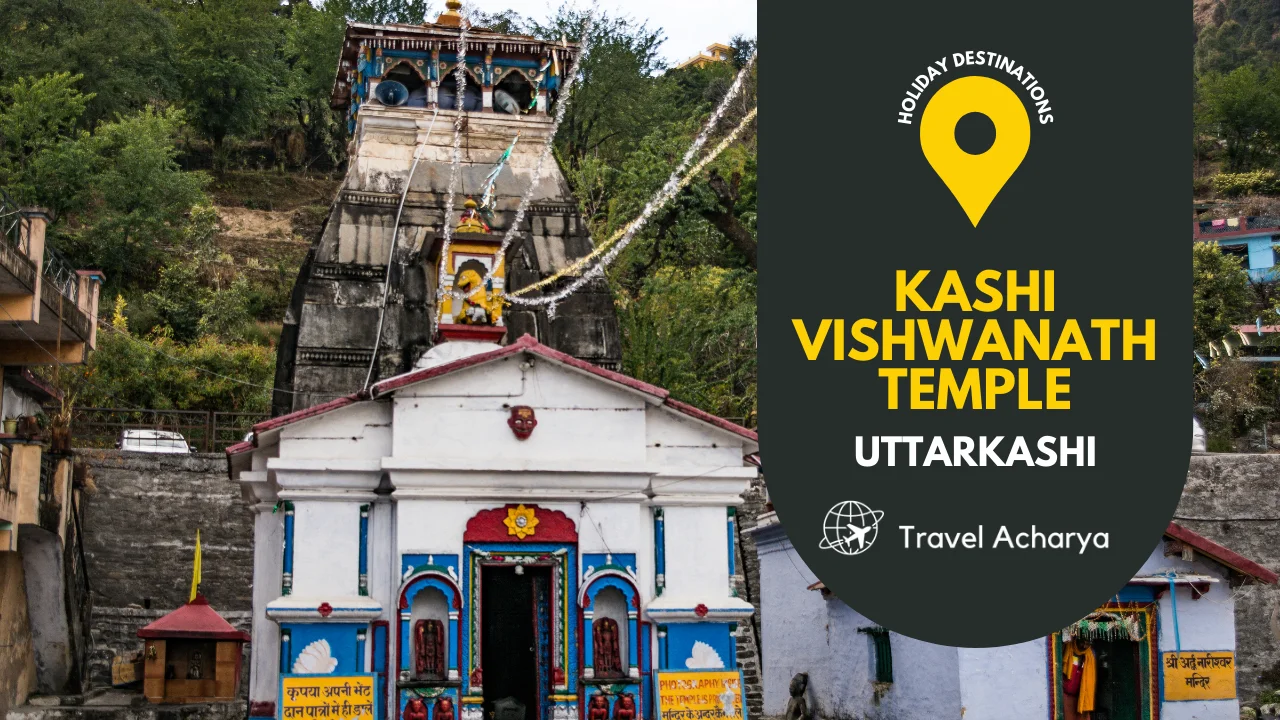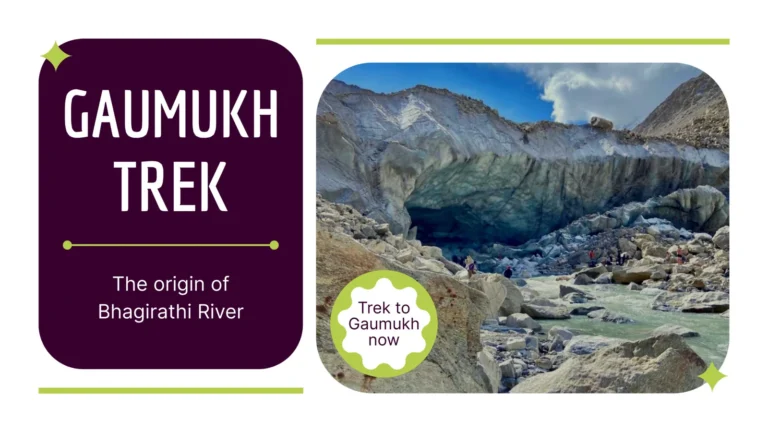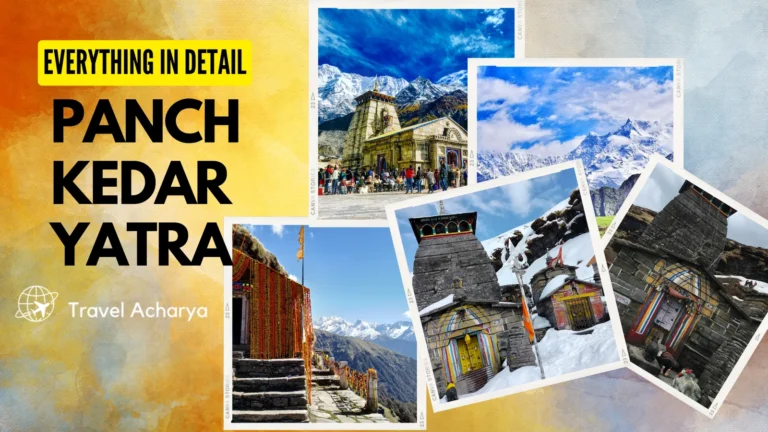Welcome to Travel Acharya, your gateway to unforgettable journeys and immersive travel experiences around the world. At Travel Acharya, we believe that travel is not just about visiting new places; it’s about creating lasting memories and discovering the true essence of each destination. In this blog post, we will take you to one of the most sacred and ancient temples in India, the Kashi Vishwanath Temple in Uttarkashi, Uttarakhand. This temple is dedicated to Lord Shiva, the supreme deity of Hinduism, and is also a part of the Char Dham Yatra, the four holy pilgrimage sites in the Himalayas. You will learn about the history, legends, architecture, features, rituals, festivals, and how to reach and where to stay near this temple. By the end of this blog post, you will be inspired to visit this temple and experience the divine blessings of Lord Shiva. So, let’s begin our journey to the Kashi Vishwanath Temple in Uttarkashi, the abode of Lord Shiva in the Kaliyuga.
The Architecture and Features of the Temple
The Kashi Vishwanath Temple in Uttarkashi is a magnificent example of the Himalayan temple architecture, which blends the elements of stone, wood, and metal. The temple was built by Queen Khaneti Devi in 1857 over an ancient altar, which is believed to date back to the time of the Mahabharata. The temple has a simple and elegant structure, with a square sanctum, a conical spire, and a porch. The main attraction of the temple is the 56 cm high Shivling, which has a tilt to the south. The Shivling is made of black stone and is adorned with a silver snake and a trident. The temple also houses the idols of Goddess Parvati and Lord Ganesha, the image of Sakshi Gopal and the sage Markandeya, and the Nandi in the outer chamber. The temple is decorated with bells, lamps, and paintings, which create a serene and spiritual atmosphere. The temple also has a library containing rare manuscripts and books on Hinduism and Vedanta.
The Rituals and Festivals of the Temple
The Kashi Vishwanath Temple in Uttarkashi is one of the most sacred and ancient temples dedicated to Lord Shiva, the supreme deity of Hinduism. The temple is situated on the banks of the Bhagirathi River, which originates from the Gangotri Glacier, one of the sources of the holy Ganga River. The temple offers a spectacular view of the river and the surrounding mountains, creating a serene and spiritual atmosphere for the devotees.
The Daily and Special Rituals
The temple is open for visitors from 6 am to 9 pm daily. The main rituals that are performed at the temple are:
- Aarti: Aarti is a form of worship in which the priests offer lighted lamps, incense, flowers, and other items to the deity while chanting hymns and prayers. The aarti is performed four times a day: at sunrise, noon, sunset, and night. The aarti is a way of expressing gratitude and devotion to the lord and seeking his blessings.
- Abhishek: Abhishek is a ritual in which the idol of the lord is bathed with water, milk, honey, curd, ghee, and other substances. The Abhishek is done to cleanse and purify the idol and to invoke the presence of the lord. The abhishek is performed by the priests or by the devotees who wish to offer their service to the lord.
- Prasad: Prasad is a term that means the food or sweets that are offered to the lord and then distributed among the devotees as a sign of his grace and mercy. The prasad is usually prepared by the temple staff or donated by the devotees. The Prasad is considered to be sacred and auspicious and is consumed with reverence and faith.
Offerings: Offerings are the items that are given to the lord as a gesture of love, respect, and gratitude. The offerings can include flowers, fruits, clothes, jewellery, money, or anything that the devotee wishes to give. The offerings are placed at the feet of the idol or in a donation box. The offerings are used for the maintenance and welfare of the temple and the priests.
The Auspicious Days and Timings
Thousands of pilgrims visit the temple throughout the year, but there are some special days and timings that are considered to be more auspicious and beneficial for the devotees. Some of these are:
- Mondays: Mondays are dedicated to Lord Shiva and are believed to be the best days to worship him and seek his favours. Devotees observe fasts, perform abhishek, and chant mantras on Mondays to please the lord and fulfil their wishes.
- Shivaratri: Shivaratri is a festival that celebrates the marriage of Lord Shiva and Goddess Parvati. It falls on the 14th day of the dark fortnight of the month of Phalguna (February-March). Devotees stay awake all night, perform abhishek, sing bhajans, and meditate on the lord on this day. It is said that whoever worships Lord Shiva on Shivaratri attains liberation from the cycle of birth and death.
- Shravan: Shravan is the fifth month of the Hindu calendar (July-August) and is considered to be the most favourable month for worshipping Lord Shiva. The whole month is dedicated to the lord and his consort, Goddess Parvati. Devotees observe fasts, perform abhishek, and offer bilva leaves, which are dear to the lord, on every Monday of this month. Many devotees also undertake a pilgrimage to the holy places associated with Lord Shiva, such as Uttarkashi, Gangotri, Kedarnath, and Varanasi, during this month.
Akshaya Tritiya: Akshaya Tritiya is a festival that falls on the third day of the bright fortnight of the month of Vaishakha (April-May). It is considered to be a very auspicious day for starting any new venture, buying any valuable item, or performing any charity. It is also believed that any worship or donation done on this day yields eternal rewards. Devotees visit the temple and offer gold, silver, or other precious metals to the lord on this day.
The Major Festivals
The temple celebrates many festivals throughout the year, but some of the major ones are:
- Mahashivaratri: Mahashivaratri is the grandest festival of the temple and is celebrated with great pomp and fervour. It falls on the 14th day of the dark fortnight of the month of Magha (January-February). It is believed that on this day, Lord Shiva manifested himself as a column of light, known as the Jyotirlinga, at 12 different places in India, one of which is Uttarkashi. The temple is decorated with lights, flowers, and flags, and a huge fair is organized in the town. Devotees throng the temple from far and near to witness the special aarti and Abhishek that are performed on this day. The festival lasts for three days and culminates with a grand procession of the lord’s idol on a chariot, accompanied by music and dance.
- Ganga Dussehra: Ganga Dussehra is a festival that marks the descent of the Ganga River from heaven to earth. It falls on the 10th day of the bright fortnight of the month of Jyeshtha (May-June). It is believed that on this day, the Ganga River was brought down by King Bhagiratha, a descendant of King Sagara, whose 60,000 sons were burnt to ashes by the sage Kapila for disturbing his meditation. The Ganga River washed away their sins and liberated their souls. Devotees take a dip in the river, perform puja, and offer lamps and flowers to the river on this day. The temple also conducts a special aarti and Abhishek for the lord and the river on this day.
- Makar Sankranti: Makar Sankranti is a festival that marks the transition of the sun from the southern to the northern hemisphere. It falls on the 14th or 15th of January every year. It is considered to be a very auspicious day for performing any religious or spiritual activity. Devotees visit the temple and offer sesame seeds, jaggery, and khichdi (a dish made of rice and lentils) to the lord and the river on this day. The temple also organizes a kite flying competition and a cultural program on this day.
- Diwali: Diwali is the festival of lights that celebrates the victory of good over evil. It falls on the 15th day of the dark fortnight of the month of Kartika (October-November). It is believed that on this day, Lord Rama, the seventh incarnation of Lord Vishnu, returned to his kingdom of Ayodhya after defeating the demon king Ravana, who had abducted his wife Sita. Devotees light lamps, candles, and crackers, and exchange sweets and gifts on this day. The temple is illuminated with lights and lamps, and a special aarti and Abhishek are performed for the lord on this day.
How to Reach and Where to Stay Near the Temple
The Kashi Vishwanath Temple in Uttarkashi is easily accessible by road, rail, and air. The temple is situated near the main market of Uttarkashi on the Rishikesh-Gangotri route. Here are some details about how to reach and where to stay near the temple:
By Road
Uttarkashi is well connected by road with major cities and towns of Uttarakhand and neighbouring states. There are regular buses and taxis available from Dehradun, Haridwar, Rishikesh, Tehri, Mussoorie, and other places to Uttarkashi. The distance and time from some of these places are:
- Dehradun to Uttarkashi: 145 km / 4 hours
- Haridwar to Uttarkashi: 180 km / 5 hours
- Rishikesh to Uttarkashi: 150 km / 4.5 hours
- Tehri to Uttarkashi: 75 km / 2 hours
- Mussoorie to Uttarkashi: 115 km / 3 hours
By Rail
The nearest railway station to Uttarkashi is Rishikesh, which is about 150 km away. Rishikesh is connected by train with Haridwar, Dehradun, Delhi, and other major cities of India. From Rishikesh, one can take a bus or a taxi to Uttarkashi.
By Air
The nearest airport to Uttarkashi is Jolly Grant Airport in Dehradun, which is about 160 km away. Jolly Grant Airport is connected by flight to Delhi, Mumbai, Bangalore, and other major cities of India. From Dehradun, one can take a bus or a taxi to Uttarkashi.
Conclusion
The Kashi Vishwanath Temple in Uttarkashi is a must-visit destination for anyone who wants to experience the divine presence of Lord Shiva and the sacredness of the Ganga River. The temple is not only a place of worship, but also a place of history, culture, and nature. The temple has witnessed many legends and miracles and has been a source of inspiration and solace for countless devotees. The temple also showcases the vibrant traditions and festivals of Uttarakhand, which reflect the faith and devotion of the people.
By visiting the temple, one can attain peace, happiness, and prosperity in life. One can also seek the blessings and guidance of the lord, who is the destroyer of evil and the giver of boons. The temple is a symbol of the eternal bond between the lord and his devotees, and the harmony between the human and the natural world.
If you are looking for a spiritual and adventurous journey, then you should plan a trip to the Kashi Vishwanath Temple in Uttarkashi. You will not only witness the beauty and glory of the temple, but also explore the scenic and serene surroundings of Uttarkashi, which is also known as the Devbhoomi, or the land of gods. You will surely have a memorable and enriching experience that you will cherish for a lifetime.
Are you ready to explore the wonders of Uttarakhand and Himachal Pradesh with Travel Acharya? Whether you want to experience the spiritual bliss of Char Dham Yatra, the scenic beauty of Leh-Ladakh, or the cultural richness of Haridwar and Rishikesh, we have the perfect tour package for you. Travel Acharya is the best travel agency in Haridwar, offering premium yet affordable tour packages, complete ground handling services, and expert guidance. Don’t miss this opportunity to embark on a journey of a lifetime with Travel Acharya. Book your tour package now and get ready to create lasting memories and immersive travel experiences. Contact us today and let us make your travel dreams come true!







